- Definition of Blood
Blood is defined as specialized connective tissue containing homogenous fluid composed of liquid substance known as plasma and the formed elements RBCs , WBCs and the platelets. - It is slightly alkaline in nature pH=7.4 .
- Saltish in taste , heavier than water and viscous sticky fluid.
- Adult man has 5-6 litres and adult woman has 4-5 litres of blood.
- The science that deals with the study of blood is called Hematology .
Composition of Blood
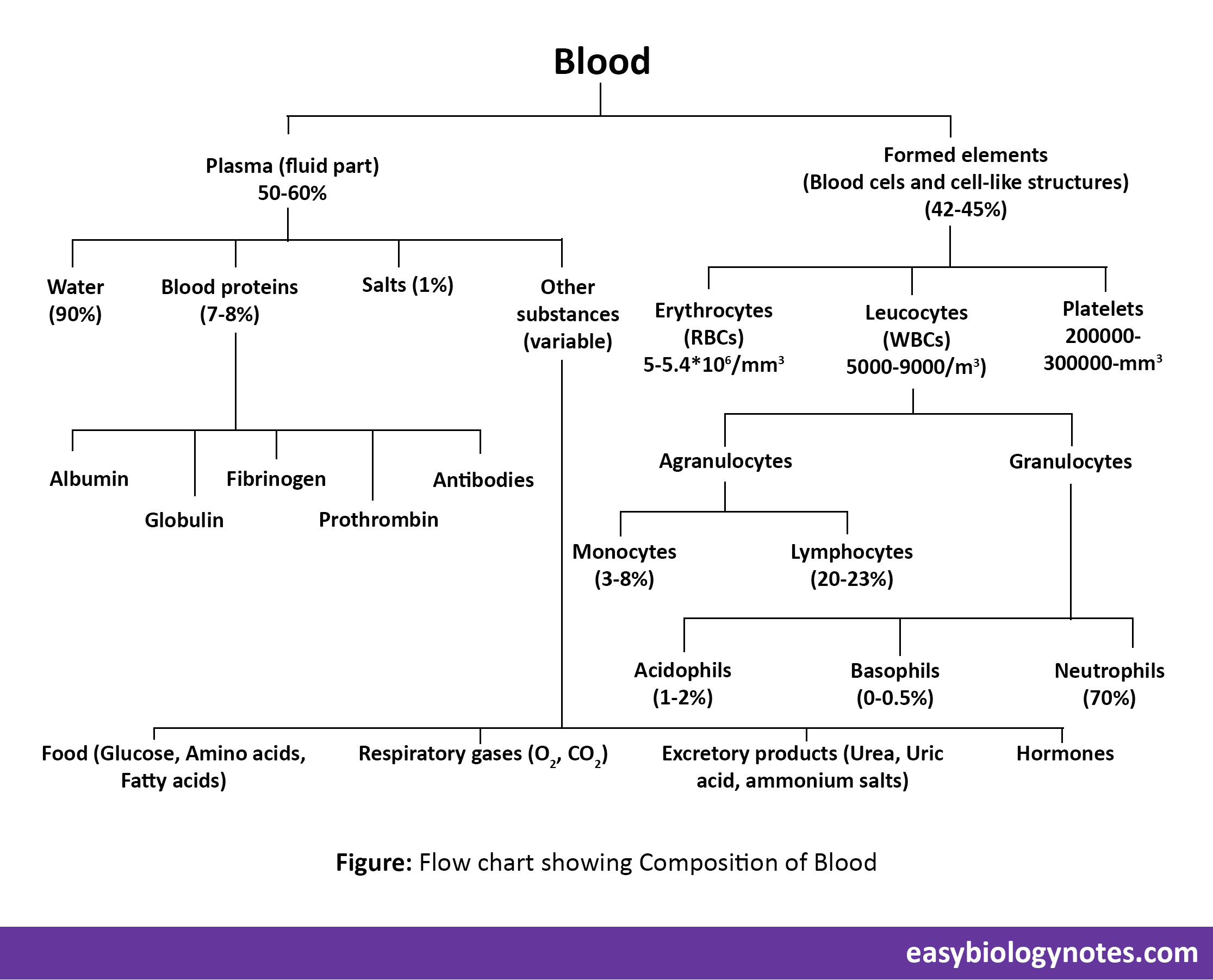
Blood consists of two major parts -:
[A] PLASMA
-
- It is the fluid part of the blood.
- Slightly yellow coloured and alkaline.
Functions of Plasma
- Transportation of digested food – Digested food, such as glucose , amino acids, fatty acids, e.t.c. , are supplied from the alimentary canal to all body cells by the way of blood.
- Transportation of Oxygen – About 3% of oxygen supplied to body cells is transported in dissolved state in the plasma.
- Transportation of CO2 – About 7% of carbon dioxide produced during oxidation of food dissolves in water of plasma.
- Transportation of metabolic wastes – Various nitrogenous waste products are transported to kidneys by way of plasma of blood for elimination.
- Transportation of Hormones – Hormones are the secretions of endocrine glands. They are transported to the target organs by the way of blood.
- Transportation of heat – Blood transports heat from the organs such as liver and muscles to the organs from where it is being continuously lost.
- Homeostasis – Maintenance of the internal environment constant is called Homeostasis. Plasma of blood helps to maintain the internal environment steady by maintaining different salts and organic substances in constant amount.
[B] FORMED ELEMENTS OR CELLULAR COMPONENTS
-
- These include microscopic cells or cell – like structures which float freely in the plasma.
These are of three types -:
1. Red Blood Corpuscles (RBCs) or Erythrocytes
-
- These are very small , 7.7 micrometer in diameter , biconcave, disc-like , de-nucleated cells in the mammalian blood.
- RBCs are red in color because of the presence of a respiratory pigment called hemoglobin.
- Hemoglobin is a conjugated protein which is composed of hematin – an iron containing pigment and globin – a protein.
- Hb has a great affinity for oxygen.
- Number of RBCs in-
- Adult man – 5 to 5.4 million/mm3
- Adult Woman – 4 to 4.5 million/mm3
- Polycythemia – Increase in RBC count.
- Erythropenia – Decrease in RB count.
- The average life of a RBC is about 120 days.
- In adults RBCs are produced in Red Bone Marrow of long bones – Ribs, Ilium of hip bones, vertebrae.
- In an embryo, these are produced in liver and spleen.
- RBCs are destroyed in the liver and spleen. Their iron part is stored in the liver cells whereas the rest is excreted as bile pigment.
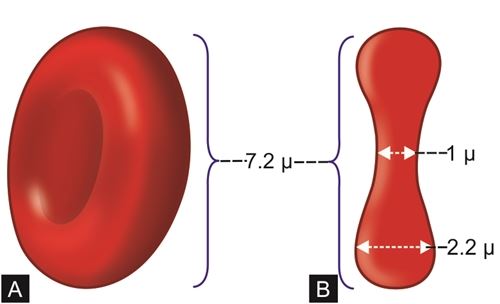
Figure: Shape and Dimensions of RBCs
Functions of RBCs
- Transportation of O2 – Hb has a great affinity for oxygen and it forms an unstable compound oxyhemoglobin (oxyHb) with O2 . This oxyhemoglobin dissociates into Hb and O2 in the body tissues and the oxygen is supplied to cells.
- Transportation of CO2 – About 23% of carbon dioxide produced in the cells is carried from the tissue to respiratory organs by hemoglobin in the form of carbaminohemoglobin (HbCO2) .
2. White Blood Corpuscles (WBCs) or Leucocytes
-
- These are amoeboid (i.e. , without any definite shape) nucleated corpuscles.
- These are larger than RBCs.
- Number of WBCs – 5000-9000 /mm3
- Increase in number of WBC count is called Leukemia .
- Decrease in number of WBC count is called Leukopenia .
- They are produced in bone marrow or in the lymph nodes, spleen.
- They are known as phagocytes – as they engulf the foreign bodies.
- They are known as scavengers – as they engulf the worn out tissues of the body.
- They are the soldiers of the body – as they accumulate at the site of injury and fight with the invading microbes that may cause infection.
- Average life-span of leucocytes is about 1 week.
Types of WBCs
(a) Agranulocytes
Cytoplasm lacks granules. They have single large nucleus.
These are further of two types :
- Monocytes
- They are largest sized leucocytes.
- Size – 12 to 20 micrometer .
- They have large kidney shaped nucleus.
- They help in engulfing foreign particles as well as worn out tissues of the body (phagocytosis).
2. Lymphocytes
- Round in shape and are of the size of RBCs.
- Nucleus large and rounded.
- They are produced in lymph nodes and spleen.
- These are not phagocytic.
- They produce antibodies that provide immunity against specific diseases.
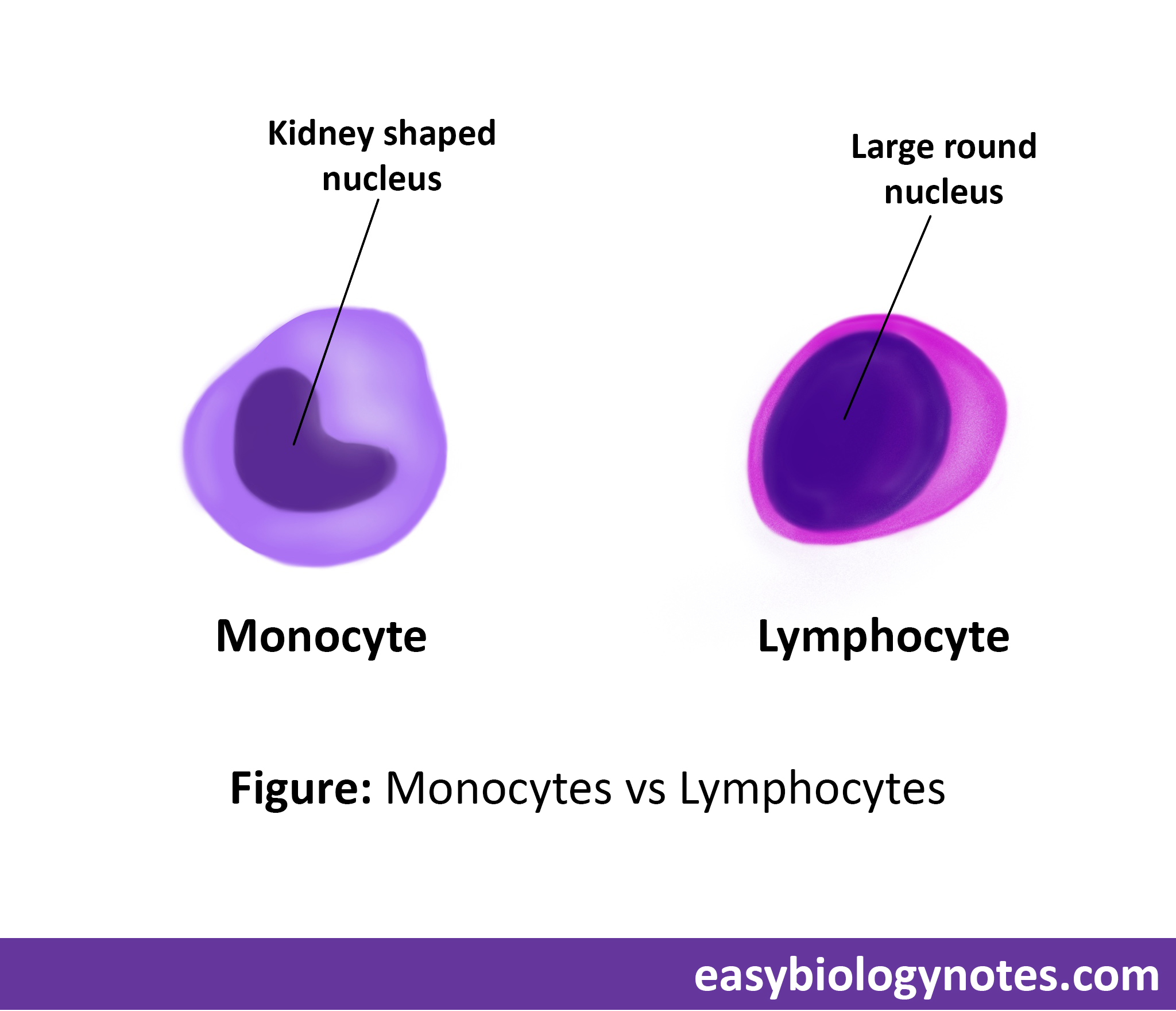
(b) Granulocytes
- They have granular cytoplasm and are produced in Red Bone Marrow.
Depending upon the chemical nature of their cytoplasm they are of three types :
- Acidophils (Eosinophils)
- Cytoplasm is alkaline in nature.
- They have bilobed nucleus.
- Their function is to engulf bacteria, secrete anti-toxin and is associated with allergy.
2. Basophils
- Their cytoplasm is acidic in nature.
- Nucleus is three lobed.
- They release chemicals called histamine for inflammation that dilates blood vessels.
3. Neutrophils
- Their cytoplasm is neutral.
- Nucleus is three to four lobed.
- They are phagocytic.
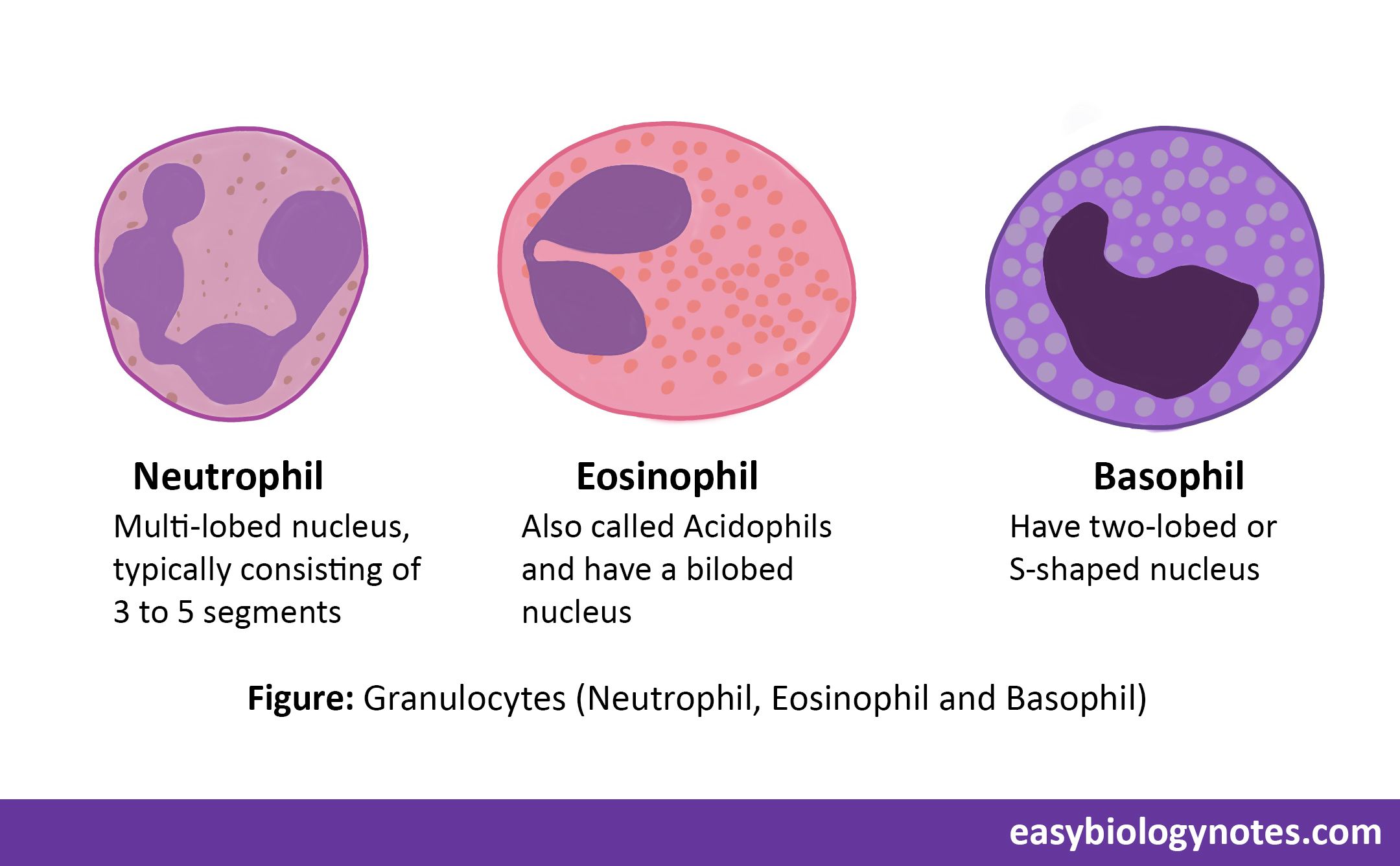
Functions of WBCs
- Phagocytosis – The engulfing of particles like solid substances such as bacteria, worn out tissues e.t.c. is called Phagocytosis.
- Neutrophils and Monocytes engulss pathogens which may enter the body and protect us against diseases.
- WBCs have the property to squeeze through the walls of capillaries known as diapedesis at the site of injury to fight with the pathogens
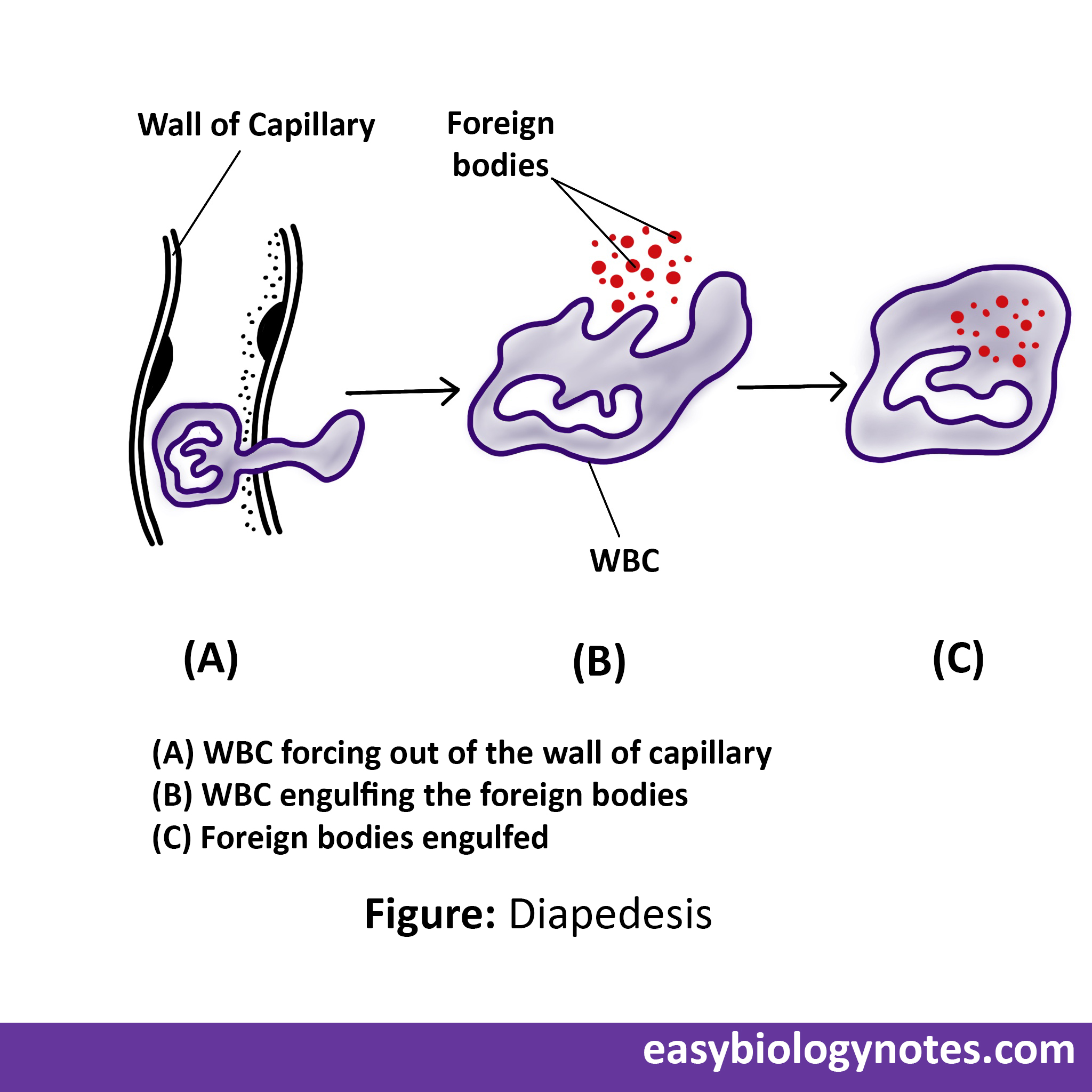
Figure: Diapedesis
- Formation of antibodies and anti-toxins
- Lymphocytes produce antibodies which fight with the antigens or pathogens (disease causing microbes) and protect the body against specific disease.
- Acidophils produce antitoxins that neutralize the toxins produces by germs and protect the body.
- Immunity
- Resistance of the bodies against diseases is called immunity.
- Lymphocytes are responsible to promote immunity.
- Inflammation
- Increased local heat , redness, swelling and pain due to reaction of tissues to injury and to localized invasion of germs is called inflammation.
[C] Platelets or Thrombocytes
-
- These are smallest sized blood cells.
- Number varies from 2 to 3 lakh /mm3 of blood.
- These are denucleated.
- Produced in Red Bone Marrow and destroyed in spleen.
Functions of Platelets
- They are responsible for clothing of the blood at injuries.
- It produces an enzyme called thrombokinase which initiates a chain of reaction involved in blood clotting.
*Hematopoiesis – Production of blood cells is called hematopoiesis.